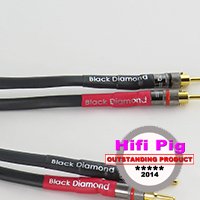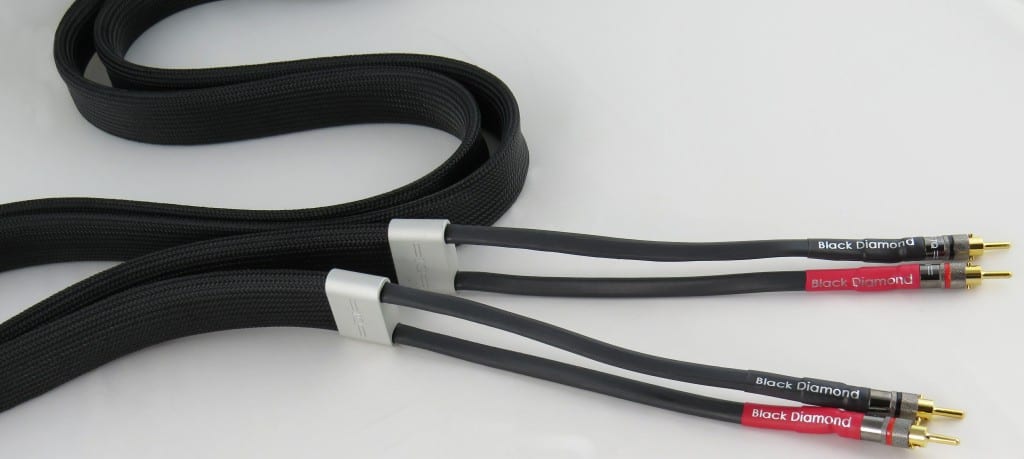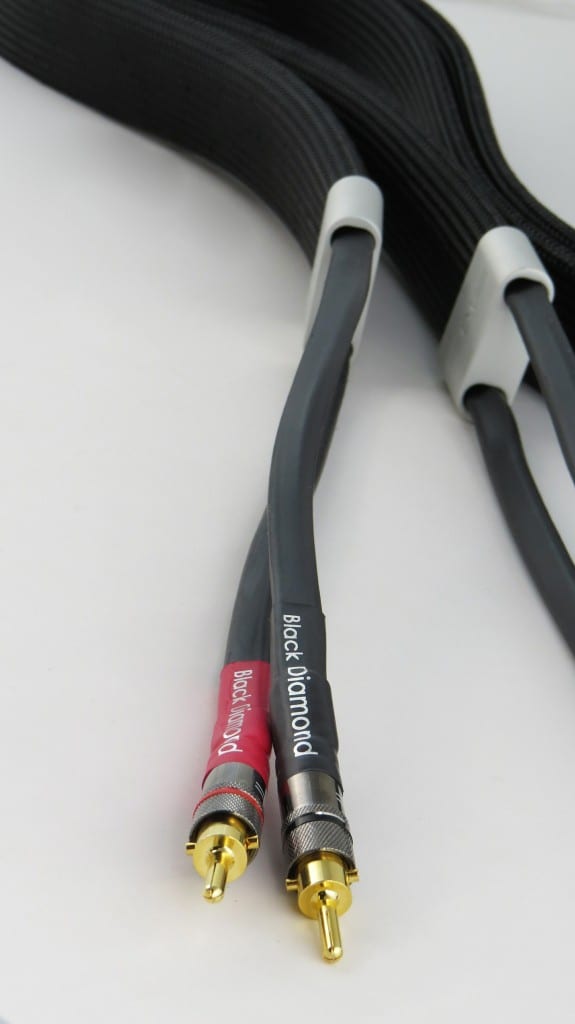The Black Diamond speaker cable from Tellurium Q is their top of the range speaker cable coming in at £630 per metre including terminations which many would confuse for WBT but they are in fact TQ’s own design.
including terminations which many would confuse for WBT but they are in fact TQ’s own design.
Yes they have an ergonomic styling similar to the WBT’s which is a testament to the design and usability of them.
TQ’s version of the 4mm banana is constructed from tellurium copper and is gold plated, the barrels are a metal alloy which are nickel plated to give a nice shiny finish and feature some nice surface grips for easy tightening of the locking design.
The cable itself as always is a mystery, all I can determine from looking at and handling the cable is that it is fractionally wider than the Ultras and where the Ultras have the conductor in a rounded cavity to each side of the cable the Black Diamond has a different shape to its borders feeling as if it has separate chambers of cables running through its length. The cable is finished in a mesh and comes in a very nice satin black box.
Routing the cables into the system is trickier than the thickest of the previous TQ cables. The band of the Black Diamond is thicker and slightly stiffer. It just takes a little care and time if there are a fair few components and angles to navigate and the job is far from impossible.
The Sound
Sting’s ‘Seven Days’ from the Live at the Royal Albert Hall 2000 album conveyed a deepness of soundstage which reflected being sat about 6 rows back. I could clearly discern all band members and their stage arrangement. The depth of the performance was very true and details were exquisite from trumpet to high hats.
The cable had taken a full 24 hours to settle in the system after its burn in process on the Blue Horizon Proburn. The Black Diamond likes to be plugged into the system and just given time to relax and settle moving it’s slightly initial forwardness in the midrange back a touch, increasing natural tone, timbre and breath.
Once settled the results are simply stunning, the delicacy and refinement in the top end especially is sublime, I could clearly hear all micro details in Fleetwood Mac’s ‘Everywhere’ and ‘Seven Wonders’ leaving nothing masked and conveying everything with a textured flow, a complete harmonious rendition of frequencies floating gracefully around the soundstage like fireflies over a moonlit pond.
Micro dynamics were absolutely effortless and more to the point, natural. There was no over-emphasis on power just a keen respect for precision and timed just so well.
Derrin Nuendorf’s ‘I Won’t Hold You Back’ has a soft cymbal work in the background, ticking away like a clock timing each section of guitar string work which has a crystalline and prestigious edge to each note, entering the fullness of the note and decaying with timbral vibrancy and scale which gives an impression of size to the guitar. The same is true for Derrin’s vocal which clearly comes from a foot or so above the guitar giving the impression that he is sat and somewhat hunkered over the instrument.
crystalline and prestigious edge to each note, entering the fullness of the note and decaying with timbral vibrancy and scale which gives an impression of size to the guitar. The same is true for Derrin’s vocal which clearly comes from a foot or so above the guitar giving the impression that he is sat and somewhat hunkered over the instrument.
Soundstage width and complexity has a way of expressing its abilities even with the most stripped down music allowing for small venue interactions, reflections and acoustics to convey their ambience and scale in a most holographic manner. Whilst busier quartets, orchestras and studio recording generated larger complements with attack with slam, large scale and drama bring the performance to life with an inner energy and grip of realism.
When listening to some various recording by the Royal Philharmonic Orchestra, double bass fluidity and the dynamic slam of percussion was incredibly intense, I would refer to the sensation as a sound wave or pressure field which is closer to a live performance rather than a synthesized punch and drone.
I wouldn’t say that I felt the Black Diamond’s bass in my system was devastating, huge or bold but I can confidently state that it has an entire shape and skill that can be fast, slow and expressive, delicate or rhythmic.
Touching on my last word of explanation of the the Black Diamond’s flexible bass characteristics ‘rhythmic’ and moving through some varying genres of pop, dance, folk and R&B the lower end took on a new found enthusiasm for me that just the natural alignment it possessed with acoustic and classical music.
To hold a good flow to the music a system needs to have a good bass-line, a strong undertone and a bottom end to support and carry the music along and the Black Diamond’s were very even handed in respects of being able to deliver particularly great mid and upper tones with a strong chassis to stiffen everything up giving strength and stability.
I would say that my own reference cable the Audioquest K2 has a hugely detailed, refined and somewhat relaxed top end. The Black Diamond has an exquisite top end, it’s highly polished, crisp, controlled and transparent and integrates down into the midrange flawlessly which is very liquid.
Any male vocalist I played from Ben Howard, Ben Harper, Jo Savoreti, Sean Lakeman and many many more had a reflection of their individual tonalities that sounded extremely true and effortless, the K2 in the midrange is just a marvel and to give any other speaker cable high praise in the same sentence calling it organic and expressive of all midrange characteristics and potential flaws is a testament to its designer.
Equally poised were female artists, the projection of the upper mids could be so intense with the Black Diamond and still remain controlled and not suffer with peaks of eye shattering wincing was remarkable, many high end cables use networking boxes to attenuate this frequency but the Black Diamond simply takes it in its stride and adds no unwanted nasties or even begins to try and hype up the signal its receiving, it’s more like a gentlemen standing to one side to allow the lady to comfortably pass by.
Conclusion
My time with the Black Diamond speaker cable has been extremely enjoyable, I have praised its attributes very much. You could argue that the price is a draw back but I don’t hear cables that performed as well as the Black Diamond costing any less and I listen to a great deal of cables frequently.
In fact my own Audioquest K2 although differently balanced does not walk all over the Black Diamond and some may well argue that system to system their preference would swing one way or the other. The Audioquest is staggeringly more expensive also.
With exquisite treble, beautifully fluid midband, expressively detailed bass and a dynamic range and soundstage which explores every performance in a most natural and involving way the Black Diamond from Tellurium Q is a masterpiece of cable design.
Build Quality – 9/10
Sound Quality – 9.2/10
Value For Money – 8.5/10
Overall – 8.9/10
Recommended for being a truly high end performer, a tribute to a system rather than just a means to conduct music. Sound quality is simply stunning.
Dan Worth
As is customary with Hifi Pig, whenever a product scores 8.5 or more then a second review is called for, so after Danny’s scoring ratings, I have been asked to conduct the follow up review for this cable.
Herewith is my follow up review of the Tellurium Q Black Diamond speaker cable.
This cable is awesome. What? You want MORE? Oh well, if you must.
Construction
This is some serious heavyweight cable, larger in fact than the other “wide banded” TQ cables like the Blue Diamond, Ultra Black and Graphite. Unlike the other cables however, this model has special locking 4mm 
banana plugs very similar in principle to WBT’s 0644 classic straight connectors, but manufactured to TQ’s own design brief with Tellurium Copper bodies plated in gold. They do grip very well to binding posts which helps considerably, given the weight of these cables.
I recall my comments about the Blue Diamond speaker cables (Reviewed recently in Hifi Pig) which noted that they were not very easy to make inconspicuous due to their size and propensity not to lay flat readily and the Black Diamond is no exception to that observation either. Not that anyone in reality is really bothered by that, are we?
Priced at £630.00 per linear metre they are not exactly cheap, nor are they the dearest on the market either. Value is a sliding scale however and given that we all strive for the “perfect” sound from the pounds we invest in it, then we expect a fair return for that outlay.
Sound
As you can probably imagine, us reviewers do get a goodly number of cables passing through our hands as part of our function to appraise hifi components and not forgetting either we play with our own personal cables as well for good measure, so it takes an exceptional cable to really get itself noticed.
From that first few bars of music I heard through these cables I knew they were something rather special. It was a kick drum in fact and it hit me square in the pit of my stomach is was so clean and powerful, it fair took me aback. The CD I was playing was only a warm up track I play to get the system warmed up ready for some serious listening and wasn’t paying too much attention to be honest because of that.
Anyway, after hearing those first few moments I quickly changed the CD to Pink Floyd’s “The Wall” and the next hour and a half or so was a complete revelation. No, make that three hours – I listened to it again just for the sheer pleasure of it. When I say the word “helicopter” you Pink Floyd fans will know exactly what I am talking about now and I have never heard that sound better in 20+ years than I have with the TQ Black Diamonds in my system. If I shut my eyes I wouldn’t know any better than having this machine hovering less than 50 feet above me with the vortexes spinning of the tips of the twin rotor blades, making the classic whistling sound. When the children are singing during the title track it can hurt your ears a bit with the volume turned right up, but not at all this time. No muddle, no hash, no moments to make you wince, smooth as silk and bursting with refinement. I even got the sonic impression of how many children were singing in the chorus, it was just so palpable. The list was endless of all the extra details I was hearing and I must have heard this album many, many hundreds of times over the years since it’s first release and hearing it this way has set a new benchmark for me what sound lies buried in there, never heard before, but now has been heard for sure.
Next into the drawer was Yello’s “Flag” album and that also got two hearings, with every single track on the album a total pleasure, again another album I believed I knew intimately what it sounded like until I heard it through the Black Diamonds. Those that have heard this album will know that is has a powerful propelling bass line right throughout the CD and the sense of power, precision and timing with the Black Diamonds was never in any doubt. “Otto Di Catania” from this album is one of my favourites and the imaging and sound staging are exemplary, with depth, height and width well out beyond the speaker boundaries.
Next into the CD drawer is my preferred “murder track” from Porcupine Tree’s “Deadwing” album, which really does sort out who’s who when it comes to components – especially cables. The title track has all sorts of  squeaks and screeches in the initial minute of the track and I was always puzzled what the sounds were, but not now. The TQ Black Diamonds have let me clearly hear the sounds are from an Underground (“Subway” to our transatlantic cousins) train pulling into a station, with people disembarking. This is both good and bad news, because there is now a danger that other cables that pass through my hands are going to be thought less of after hearing what the Black Diamonds could do with Deadwing. Fear not readers, I will be as unbiased and dispassionate as ever towards all that follow.
squeaks and screeches in the initial minute of the track and I was always puzzled what the sounds were, but not now. The TQ Black Diamonds have let me clearly hear the sounds are from an Underground (“Subway” to our transatlantic cousins) train pulling into a station, with people disembarking. This is both good and bad news, because there is now a danger that other cables that pass through my hands are going to be thought less of after hearing what the Black Diamonds could do with Deadwing. Fear not readers, I will be as unbiased and dispassionate as ever towards all that follow.
I think Dan has done a pretty good job of describing all the finer points of the Black Diamond’s performance, so there isn’t that much I can add to it in truth without repetiton, so perhaps if I summarise what the cables don’t do just to add another dimension to this report to give you a clearer picture of this cable’s capabilities. They don’t boom or overhang at all anywhere in the bass. There is no cloudiness, haze or congestion in the midband. Treble is not harsh or fizzy, no sting, no unpleasant artifacts. They do not have a flat two-dimensional perspective to the imaging and sounstage, nor are they curtailed in width or height. Dynamics and transients are not slow or slurred. They are not at all forward sounding or brash, nor are they recessive or muted in sound either. My evaluations always concentrate on these attributes in great detail and if there were any issues found then be assured they would certainly be included in this review.
Conclusion
£630.00 per linear metre terminated. Let’s get that out of the way first, because some of you will have a frowned expression while reading that figure. Many of you will already have tried this, that and the other cables during the ownership of your hifi systems and nobody can escape the losses incurred while on that journey of buying and selling. If I said to you the TQ Black Diamonds just might be the last speaker cables you will buy, then suddenly the price isn’t as vexing as the figure might at first suggest, so in a perverse way they could actually save you money by ending that endless search. What you will hopefully be auditioning is a cable that has so little wrong with it, it just sounds so RIGHT in every way imaginable and you could probably count on one hand the number of high end cables that could be claimants to that particular crown and the TQ Black Diamond costs much less than it’s immediate rivals.
My time with them has been a total joy and a learning experience too, in that I have heard so much more details from my CD collection that simply have not been manifested for more years than I care to remember and some of them have been listened to hundreds if not thousands of times, played on some esoteric high end systems no less. I will listen to Pink Floyd’s “The Wall” album in a completely new light from now on.
The real acid question then is, would I buy them myself?
How much would a Kidney fetch these days I wonder?
Build Quality – 9/10
Sound Quality – 9.3/10
Value For Money – 8.5/10
Overall – 8.93/10
Recommended for being probably the last cable you will need to buy. Stunning performance.
Dominic Marsh



















































































































































































































You must be logged in to leave a reply.